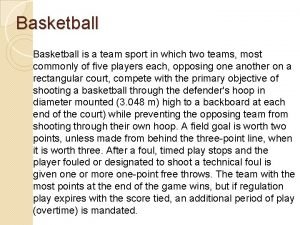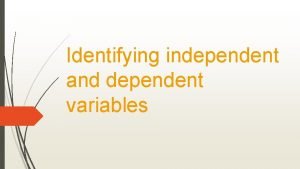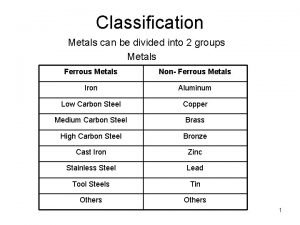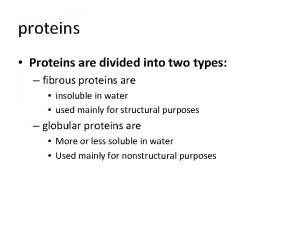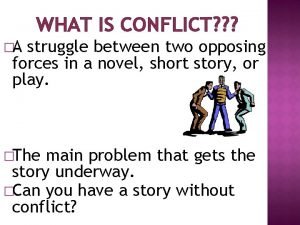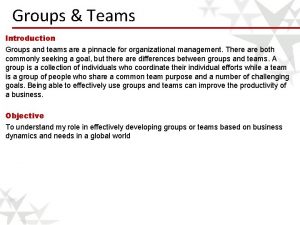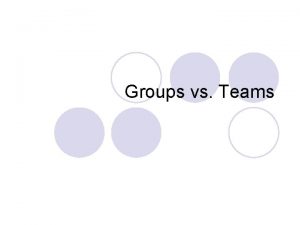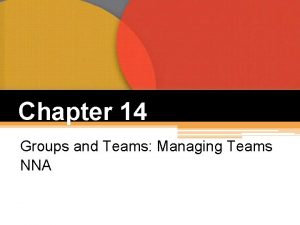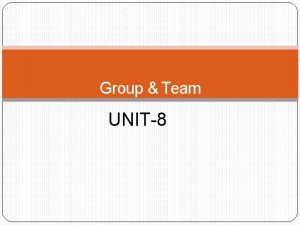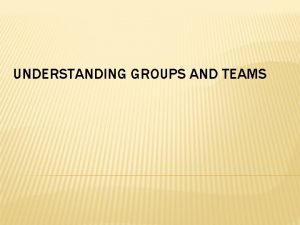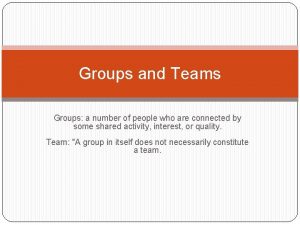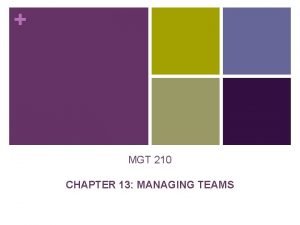Managing Teams Groups and Teams Group Two or

















- Slides: 17

Managing Teams

Groups and Teams • Group – Two or more persons who are interacting in such a way that each person influences and is influenced by each other person. • Team – A group of people committed to a common purpose, set of performance goals, and approach for which the team members hold themselves mutually accountable. 2

Comparing Work Teams and Work Groups 3

The Popularity of Teams • Teams typically outperform individuals when tasks require multiple skills, judgment, and experience • Teams are a better way to utilize individual employee talents • The flexibility and responsiveness of teams is essential in a changing environment • Empowered teams increase job satisfaction and morale, enhance employee involvement, and promote workforce diversity 4

Types of Work Teams 5

What It Takes to Be a Team Player • Personality – Individualism versus collectivism • Interpersonal Skills – Conflict management skills – Collaborative problem solving skills – Communication skills • Management Skills – Develop and establish goals – Control, monitor, provide feedback – Set work roles and assign tasks 6

Team Member Roles 7

Challenges to Creating Team Players • Managers attempting to introduce teams into organization face the most difficulty: – When individual employee resistance to teams is strong – Where the national culture is individualistic rather than collectivist – When an established organization places 8

Workforce Diversity’s Effects on Teams • Fresh and multiple perspectives on issues help the team identify creative or unique solutions and avoid weak alternatives • The difficulty of working together may make it harder to unify a diverse team and reach agreements • Although diversity’s advantages dissipate with time, the added-value of diverse teams increases as the team becomes more cohesive 9

How to Build a Productive Team þ þ þ þ Have clear mission/purpose. Set specific performance goals. Compose the right team size and mix. Have an agreed-upon structure appropriate to the task. Delegate the authority to make the decisions needed, given their mission. Provide access to or control of the resources needed to complete their mission. Offer a mix of group and individual rewards. Foster longevity and stability of membership. 10

Characteristics of High-performing Work Teams 11

Why Teams Fail: The Leadership, Focus, and Capability Pyramid Source: Adapted from Steven Rayner, “Team Traps: What They Are, How to Avoid Them. ” National Productivity Review. Summer 1996, p. 107. Reprinted by permission of John Wiley & Sons, Inc. 12

Symptoms of Unproductive Teams þ þ þ Nonaccomplishment of goals. Cautious, guarded communication. Lack of disagreement. Malfunctioning meetings. Conflict within the team. 13

Stages of Team Development May 9, 2006 LIS 580 - Spring 2006 Prentice Hall, 2002 14

How to Improve Team Performance • Select members for skill and teamwork. • Establish challenging performance standards. • Emphasize the task’s importance. • Assign whole tasks. • Send the right signals. • Encourage social support. • Make sure there are unambiguous team rules. • Challenge the group regularly with fresh facts and information. • Train and cross-train. • Provide the necessary tools and material support. • Encourage “emotionally intelligent” team behavior. 15

Providing an Organizational Context That Supports Teams Organizational Structure Organizational Systems Team Work Approach Organizational Policies Employee Skills 16

Designing Organizations to Manage Teams Source: Adapted from James H. Shonk, Team-Based Organizations (Homewood, IL: Irwin, 1997), p. 36. 17
 Understanding groups and teams
Understanding groups and teams Differences between group and team
Differences between group and team Groups and teams difference
Groups and teams difference Groups and teams difference
Groups and teams difference Understanding groups and teams
Understanding groups and teams Understanding groups and teams
Understanding groups and teams How are ethnic groups and religious groups related
How are ethnic groups and religious groups related Witch
Witch Transactional analysis group therapy
Transactional analysis group therapy Chapter 10 comparing two populations or groups answer key
Chapter 10 comparing two populations or groups answer key State two characteristics of interest groups
State two characteristics of interest groups How to identify independent and dependent variables
How to identify independent and dependent variables Types of field forces
Types of field forces Classification of metals
Classification of metals Seed plants are divided into two groups. what are they?
Seed plants are divided into two groups. what are they? Proteins are divided into two groups
Proteins are divided into two groups Drag the example to connect with the description given
Drag the example to connect with the description given The struggle between two opposing forces.
The struggle between two opposing forces.







